Innovations and Breakthroughs in Hazardous Waste Water Therapy Technologies
The landscape of industrial wastewater treatment is undertaking a transformative change, driven by developments that enhance both performance and sustainability. Arising modern technologies, such as membrane layer bioreactors and microbial fuel cells, are redefining pollutant elimination processes while adding to power generation. In addition, resource recuperation approaches are acquiring grip, aligning with round economic climate concepts. As governing requirements evolve, the integration of AI and artificial intelligence into wastewater management systems guarantees to make certain and streamline operations compliance. Nonetheless, the complete ramifications of these developments raise essential questions concerning their scalability and lasting influence on market practices.
Review of Waste Water Therapy Technologies
Wastewater treatment innovations include a series of techniques developed to remove impurities from commercial effluents prior to their launch right into the environment. These modern technologies are crucial for preserving ecological balance and ensuring conformity with environmental laws. The main categories of wastewater therapy include physical, chemical, and biological techniques, each offering distinctive functions based upon the nature of the impurities present.

Organic treatment methods use bacteria to weaken raw material, making them specifically reliable for organic-rich effluents. Methods like turned on sludge and biofilm reactors harness the all-natural deterioration abilities of bacteria, leading to significant reductions in biochemical oxygen need (FIGURE)
Advanced Filtration Techniques
Advanced filtration methods stand for an essential evolution in the world of commercial wastewater treatment, improving the performance of pollutant removal procedures. Industrial Waste Water Treatment. These methods include a variety of technologies, consisting of microfiltration, ultrafiltration, nanofiltration, and turn around osmosis, which provide sequential barriers for different bit dimensions and chemical structures
Microfiltration and ultrafiltration use membrane layer systems to remove put on hold solids, germs, and bigger organic particles, enhancing the quality of effluent before further treatment. Nanofiltration links the void in between ultrafiltration and reverse osmosis, properly getting rid of divalent ions and natural substances, thus reducing the tons on downstream processes.
Reverse osmosis uses the highest degree of purification by allowing only water and little particles to go through its semi-permeable membrane layers, making it suitable for redeeming top quality water from industrial effluents. Recent innovations in membrane layer modern technology, including the development of more long lasting and fouling-resistant products, have significantly boosted functional efficiency and lowered expenses.
Integrating these advanced purification strategies not only enhances the overall treatment procedure but also adds to sustainability efforts by making it possible for water reuse and resource recuperation in industrial settings. (Industrial Waste Water Treatment)
Biological Therapy Innovations

Furthermore, the advancement of engineered biological systems, such as membrane bioreactors (MBRs), incorporates biological treatment with advanced membrane layer purification. This integration permits greater effluent high quality and decreased footprint, making it ideal for space-constrained industrial centers. Innovations in genetically crafted bacteria have actually additionally emerged, boosting the biodegradation of certain impurities, such as drugs and hefty metals, that are typically testing to remove.
In addition, the application of bioaugmentation methods, where valuable microbes are presented to enhance the existing organic therapy procedures, has revealed promising lead to boosting therapy efficiency. These advancements collectively symbolize a trend towards more effective and sustainable biological therapy approaches that can adapt to the developing intricacies of commercial wastewater streams. As industries remain to focus on environmental conformity, these biological innovations will play a vital role in wastewater monitoring.

Resource Recovery Methods
In industrial setups, the integration of source recuperation techniques has actually ended up being increasingly crucial for boosting sustainability and lessening waste. These approaches focus on removing valuable products and energy from wastewater streams, therefore transforming possible pollutants right into reusable sources.
One noticeable strategy is vitamins and mineral recuperation, where nitrogen and phosphorus, commonly existing in excess in wastewater, are recorded and converted right into fertilizers. This not just click this site decreases ecological influences but also provides a circular economic situation remedy for agricultural applications. In addition, modern technologies such as anaerobic digestion enable the conversion of organic waste right into biogas, a renewable energy source that can offset nonrenewable fuel source usage in commercial procedures.
Moreover, advanced filtration and membrane layer innovations promote the healing of industrial spin-offs such as salts and steels. These recovered materials can be rehabilitated into production procedures, decreasing the need for virgin sources.
Future Trends in Drainage Monitoring
As sectors significantly focus on sustainability, the future of wastewater administration is set to undertake considerable makeovers. Technical advancements, such as man-made knowledge and artificial intelligence, will certainly make it possible for more efficient monitoring and management of wastewater systems. These innovations can predict upkeep demands, optimize therapy processes, and improve decision-making, eventually decreasing functional expenses and environmental influence.
In addition, the integration of circular economy concepts will play a critical role in wastewater management. Industries are anticipated to move towards systems that not only deal with wastewater but additionally recuperate important resources, such as nutrients, water, and power. This shift will minimize waste and promote the reuse of products, straightening with international sustainability goals.
Emerging treatment strategies, such as membrane layer bioreactors and progressed oxidation processes, will additionally enhance the performance of wastewater therapy, enabling better effluents ideal for reuse. In addition, regulatory a knockout post frameworks are likely to progress, highlighting more stringent standards for wastewater discharge and encouraging industries to adopt ingenious therapy solutions.
Conclusion
In final thought, the advancement of commercial wastewater treatment innovations demonstrates a substantial shift in the direction of enhanced effectiveness and sustainability. Technologies in sophisticated filtration methods, organic treatments, and resource healing techniques highlight the industry's commitment to ecological stewardship. The combination of expert system and maker discovering further maximizes these processes, guaranteeing regulative conformity and promoting a round economic climate. Continued advancements in these locations will play an essential role in forming the future of wastewater administration and protecting vital water sources.
The landscape of commercial wastewater treatment is undergoing a transformative change, driven by advancements that enhance both effectiveness and sustainability.Wastewater treatment innovations include a range of techniques created to eliminate pollutants from industrial effluents before their launch into the environment.Taking advantage of the power of biological procedures has led to significant developments in the treatment of commercial wastewater.Additionally, the application of bioaugmentation strategies, where valuable microbes are presented to enhance the existing organic therapy procedures, has actually revealed encouraging results in improving therapy efficiency. These developments collectively symbolize a fad in the direction of even more lasting and reliable organic therapy approaches that can adjust to the evolving intricacies of commercial wastewater streams.